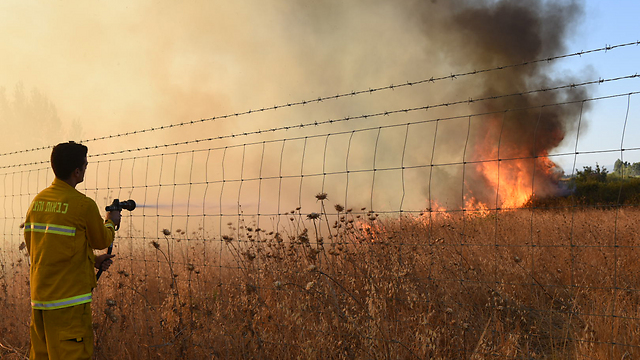
The IDF struck targets in Syria on Thursday evening after four rockets were fired at northern Israel, with two landing in the Upper Galilee and two in the Golan Heights.
The projectiles landed in open areas and there were no immediate reports of any casualties. One landed near a town, causing a fire.
The IDF said it believed the firing was deliberate and that it was considering retaliatory fire. It also said the firing originated in Syria's Quneitra area, which is under Syrian President Bashar Assad's control and in which according to reports, Hezbollah operatives Samir Kuntar and Mustafa Mughniyeh have free rein.
However, according to the IDF, Islamic Jihad was responsible for the fire, using Iranian funding and direction. The IDF also said it saw Syria as responsible for the fire. Islamic Jihad spokesman Daud Shihab strongly denied that the organization was responsible.
A senior IDF officer said: "The incident was directed by Iran – Saeed Izadi, the head of the Palestinian department of the Iranian Quds Force. He directed the rocket fire today and is active in smuggling weapons from Syria to Lebanon."
The source added that the army had struck a number of targets, including infrastructure and weapons belonging to the Syrian army. "We hold the Syrian state responsible," he added. "We attacked with tanks, artillery, and one target from the air... We attacked several kilometers into Syria, five or six sites with multiple targets within each site. Our attacks are much more severe this time around, in order to send a message and underscore the severity of this incident," he said.
"The Iranians want to heat up the front against us in the northern and southern Golan," said the officer. "It’s in the Syrian and Iranian interest."
Syrian media accused Israel of supporting terrorist organizations rebeling against the Assad regime. New outlets also reported that one Syrian had been killed in the attack and another seven had been wounded.
The retaliatory strikes conducted by the IDF were part of a newly organized large scale attack plan against Syrian targets, which was prepared in recent months by the Northern Command.
The framework came about as a result of new threats posed by Iranian forces on the Syrian Golan, and in anticipation of renewed rocket fire against Israel from this front, as was experienced this afternoon.
Combat troops from the artillery corps' Meitar unit took part in the strikes, firing their electro-optical Tamuz missiles against Syrian targets in the border region.
The IDF identified a direct link between the rocket fired aimed at Israel this afternoon, and a single mortar that was fired last week from Quneitra, which exploded in the agricultural fields near Ein Zivan.
![]()
Earlier Thursday, the air force announced it had deployed an Iron Dome missile defense battery to Ashdod in southern Israel. Gaza security coordinators received warnings Wednesday of possible rocket fire from the Gaza Strip.
They said Iron Dome was brought into the field due to the deteriorating condition of Mohammed Allaan, a suspected member of Islamic Jihad who ended his hunger strike Wednesday after more than two months, when Israel declared it was suspending his administrative detention because he had suffered brain damage.
While southern Israel has experienced several rocket sirens in recent weeks, they are rarer in the north. In June, sirens in the north were turned out to be caused by fighting in Syria. In April, two mortars landed in northern Israel, which proved to be errant shells from fighting in Syria.




















